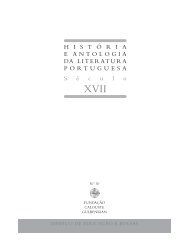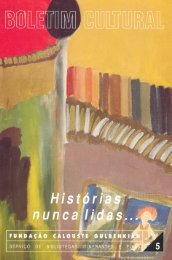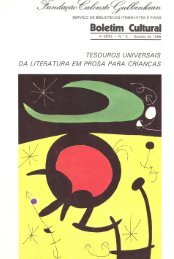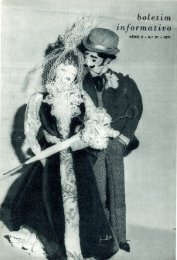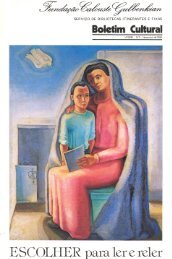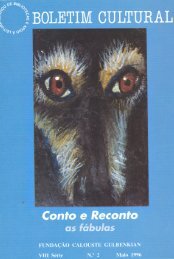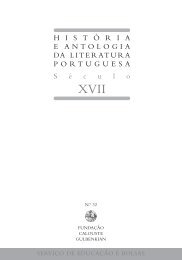Formar Leitores para Ler o Mundo - Leitura Gulbenkian - Fundação ...
Formar Leitores para Ler o Mundo - Leitura Gulbenkian - Fundação ...
Formar Leitores para Ler o Mundo - Leitura Gulbenkian - Fundação ...
You also want an ePaper? Increase the reach of your titles
YUMPU automatically turns print PDFs into web optimized ePapers that Google loves.
74<br />
The literary quality of children’s literature and its relevance for readers<br />
of all ages has been universally acknowledged. Children’s books appear<br />
on, even dominate, general bestseller lists. Harry Potter and the Sorcerer’s<br />
Stone was the first children’s book to hold the number one position on<br />
the New York Times list of hardcover bestsellers, and each of the first three<br />
books in the series held that position in turn. When their domination of<br />
the top three spots resulted in the creation of a se<strong>para</strong>te list for children’s<br />
books, it was widely felt that children’s bestsellers had every right to<br />
appear on the regular fiction list, especially since many readers were<br />
adults. Children’s books have also become contenders for prestigious<br />
mainstream literary awards. This began even before Harry Potter ushered<br />
in the crossover phenomenon. In 1995, Dianne Hofmeyr’s Boike You Better<br />
Believe It was awarded the M-Net Book Prize, the most important literary<br />
prize in South Africa, beating out J.M. Coetzee’s Master of Petersburg (Nobel<br />
Laureate Nadine Gordimer was also nominated, but withdrew). The judging<br />
criteria include literary merit and strong narrative content as well as<br />
accessibility to a broad reading public. 32 Hofmeyr told me she thinks her<br />
novel won because it was timely and captured «what was happening in<br />
the “new” South Africa just prior to Nelson Mandela coming to power». 33<br />
The final volume in Pullman’s His Dark Materials achieved what the<br />
third Harry Potter had failed, by one vote, to do two years earlier: The<br />
Amber Spyglass overwhelmingly won the 2001 Whitbread Book of the Year<br />
award, the British book world’s second highest honour after the Man<br />
Booker Prize. It became the first children’s book winner since the award’s<br />
inception to claim the overall prize, an achievement that for many had<br />
previously been inconceivable. However, a few commentators had even<br />
begun to speculate on the possibility of a children’s book winning the<br />
prestigious Booker Prize. In 1999, one British journalist wrote: «The real<br />
barrier to overcome is not one of the possibilities of the genre but the<br />
judges’ reluctance to value something that could also be valued by a<br />
child, believing that if a child could like it, it must be childish for an<br />
adult to like it.» 34 Many critics and writers were comparing children’s literature<br />
favourably with literary fiction, which had long neglected the<br />
story and had become increasingly abstruse and tedious. 35 When Pullman<br />
won the Carnegie Medal for the first volume of His Dark Materials in<br />
1996, he attacked adult novelists in his acceptance speech, claiming that<br />
many had lost the art of telling a good story. In 1999, the author reiterated:<br />
«There are very few writers of what one might call the literary Booker<br />
Prize short-list novel who are good at stories and who think stories are<br />
important.» 36 Two years later, the third volume of His Dark Materials<br />
became the first children’s book to be longlisted for the Booker Prize.<br />
This nomination led one journalist to write in The Guardian: «Segregation<br />
of genres may remain valid commercially and as a filter for parents. In<br />
judging the best writing, it is now redundant.» 37 Even the literary establishment<br />
seems finally to be acknowledging that books published for<br />
children are literary works worthy of the attention and respect of adults.<br />
The children’s books that fall into the crossover category address important<br />
moral issues of our time and invite readers of all ages to reflect on<br />
the challenging metaphysical and existential questions that concern all<br />
human beings. Crossover fiction recognizes the continuity that connects<br />
readers of all ages and acknowledges that different generations share<br />
experiences, knowledge, desires, and concerns. It offers a shared reading<br />
experience for all ages that brings the generations together in a better<br />
understanding of our world.<br />
NOTES<br />
1 Hensher, P. (2003, June 19). «Harry Potter and the Art of Making Money», in The Independent, London.<br />
2 See Nel, P. (2005). «Is There a Text in This Advertising Campaign? Literature, Marketing, and Harry<br />
Potter», in The Lion and the Unicorn 29, no. 2: 236.<br />
3 Walden, G. (2003, January 26). «A Child’s View, Again», in Daily Telegraph.<br />
4 Bloom, H. (2003, September). «Dumbing Down American Readers», in The Boston Globe 24. See also his<br />
article (2000, July 11) «Can 35 Million Book Buyers Be Wrong? Yes», in Wall Street Journal, A26.<br />
5 Holden, A. (2000, June 25). «Why Harry Potter Doesn’t Cast a Spell over Me», in The Observer.<br />
6 See Furedi, F. (2003, July 29). «The Children Who Won’t Grow Up», in Spiked.<br />
7 Myerson, J. (2001, November 14). «Harry Potter and the Sad Grown-ups», in The Independent.<br />
8 See, for example, Glistrup, E. (1997, August 31-September 5). «Children’s Literature in Denmark:<br />
Trends and Currents in the 1990s», Copenhagen: paper presented at the 63rd International<br />
Federation of Library Associations and Institutions Annual Conference; Tiberghien, M. (2000,<br />
December 1-2). «Table Ronde», round table presented at the international conference on «Perspectives<br />
Contemporaines du Roman pour la Jeunesse», Eaubonne, France: Institut International Charles<br />
Perrault.<br />
9 Mayer, A. (2006, March 14). «Sharing the Love: How Publishers are Re-branding Adult Fiction for<br />
Younger Readers», CBC, http://www.cbc.ca/arts/books/youngadultfiction.html (accessed December 6,<br />
2006).<br />
10 Rees, J. (2003, November 17). «We’re All Reading Children’s Books», in Daily Telegraph.<br />
11 Qtd. in Glistrup, «Children’s Literature in Denmark: Trends and Currents in the 1990s».<br />
12 Langton, J. (1985, July 28). Review of Handles, by Jan Mark.<br />
13 Leysen, A. (1997). «About Flemish and Dutch Literature», in A Companion to Dutch and Flemish Letters<br />
(translated from the Dutch by David Colmer and Paul Vincent), N.p.: Stichting Frankfurter Buchmesse, 46.<br />
14 Hunt, J. (2007, March-April). «Redefining the Young Adult Novel», in The Horn Book Magazine 83, vol.<br />
2: 141-47.<br />
15 It is widely believed that an increasing number of adolescents are turning to adult novels. In his<br />
article «How Publishers are Re-branding Adult Fiction for Young Readers», Andre Mayer states that<br />
«the fact that teenagers are picking up ostensibly grown-up fiction is hardly novel», but that «the difference<br />
nowadays is that publishers and vendors are becoming more proactive with young bookworms».<br />
16 Nissen J. (2000, March). «The Bookseller.»<br />
17 FitzHerbert, C. (2002, January 23). «This Author Is Original and Also Dangerous», in The Daily<br />
Telegraph.<br />
18 Craig, A. (2004, February). «Mark Haddon», in Sunday Times.<br />
19 Moeyaert, B. (2000, May 12-13). «Seven Small Stories», paper presented at the seminar «Coming<br />
Home in Children’s Literature», London: Roehampton Institute.<br />
20 Qtd. in Templeton, D. (2002, March 14-20). «Dark Days: Ghouls and Goblins, Mayhem and Murder –<br />
It’s Just Kids’ Stuff», in North Bay Bohemian.<br />
75




